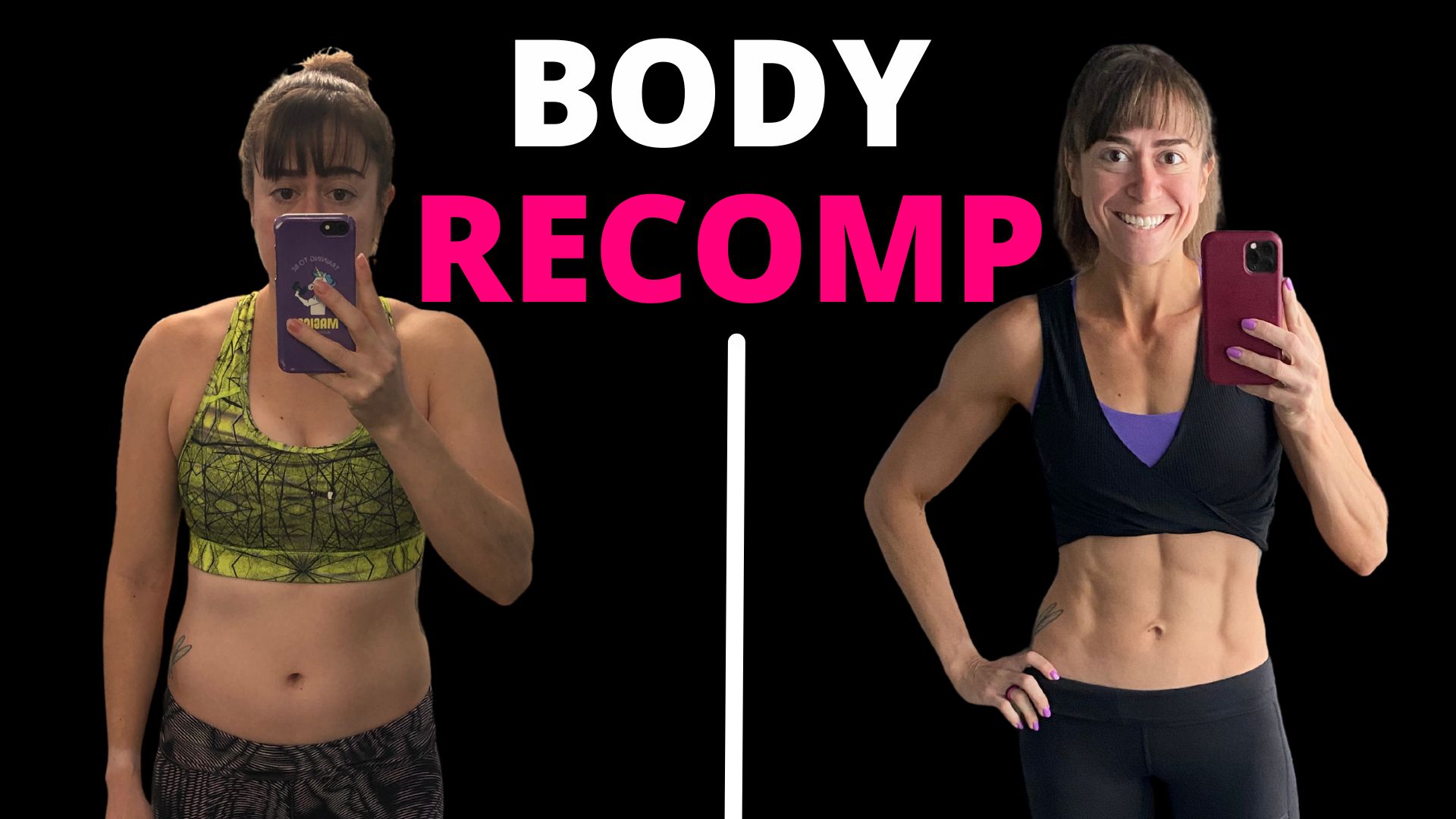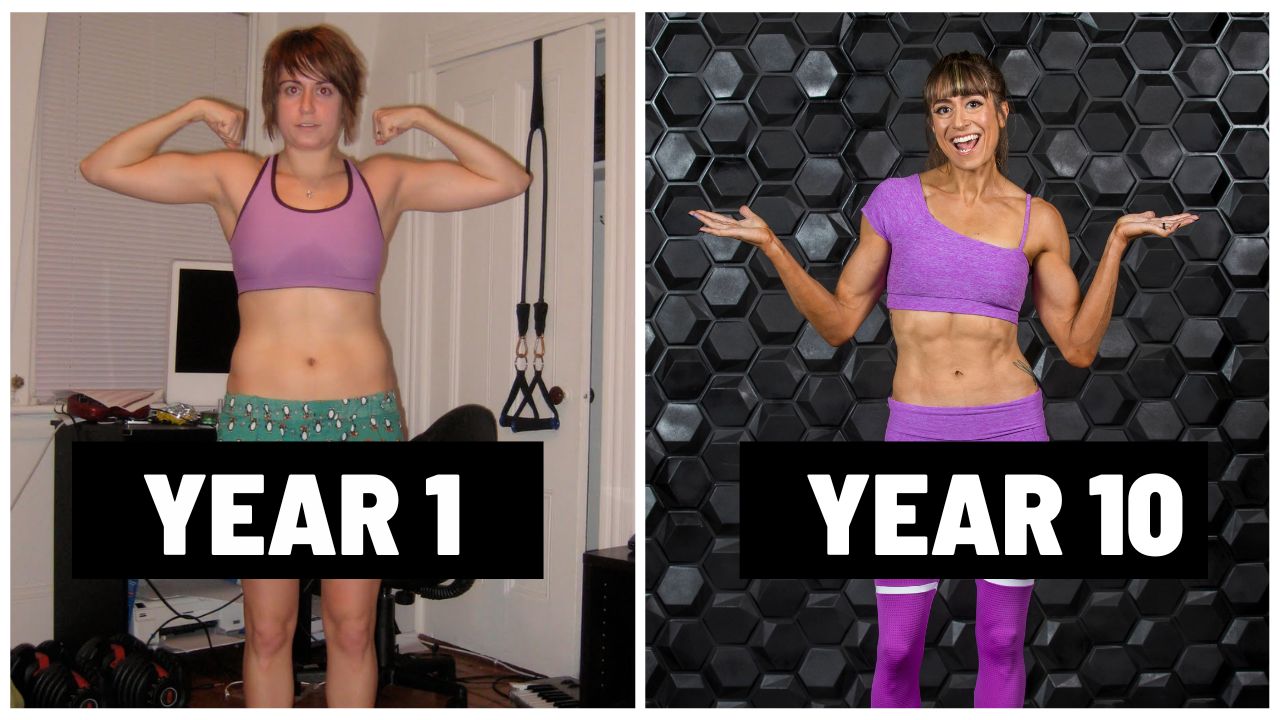
5 Tips For Muscle Growth (GAINS 101!)
So you want to build muscle…
Put down your cardio crown and get ready to eat more.
In this video I’ll cover muscle building 101, or bulking, and it’s going to require you to go against many of the dieting and training practices you’re used to, especially if you’ve found yourself constantly on that yo-yo dieting cycle over the years.
Now if you’re wondering, “Should I do a bulk?” here are some things to consider…
Are you thin and wanting to see more muscle definition?
Have you dieted down but aren’t as defined as you’d like?
Are you going through menopause and seeing weight creep on around your middle?
Are you feeling like your metabolism is broken?
Have you plateaued in your weight loss journey after being in a deficit for 6 months or more?
If you said yes to any of these, it may be time to focus on a muscle building phase.

Building muscle can improve our body composition if we’re already pretty lean, making us look leaner and more defined…
It can also improve our insulin sensitivity and metabolic health to avoid gaining unwanted fat as we get older…
And a bulking phase can even help us ultimately bust a weight loss plateau through a period of time focused on performance, metabolic health and hormonal balance while gaining muscle so we look leaner as we lose.
But I’ll tell you the thing that most often holds us back from seeing the amazing muscle gains that are possible…
And it isn’t even a nutritional mistake or workout one….although there are a few common ones I’ll go over to help you avoid them…
It’s the fear of gaining weight on the scale!
Many of us have worked hard to achieve our weight loss or fat loss goals. Often a number on the scale is tied to that.
Especially if you’ve lost weight more recently, the idea of seeing that number go up can freak you out.
But honestly, it might and you may look even leaner as it does.
If you’re serious about putting on muscle, consider ditching the scale and instead focus on body measurements and progress pictures for a bit.
If you do use the scale, be ready to see even an initial jump as you move to eating more, focusing on more carbs and even see more muscle tissue damage and inflammation from pushing hard in your workouts.
This isn’t fat nor muscle being gained. Sorry doesn’t happen that fast.
We have to remember that simply by no longer being in a deficit we won’t be depleted and our body is going to store the extra we’re giving it.
This means full energy stores. And as you build more muscle, the more you can store. But these stores are needed to see those gains.
And then as you build muscle, the scale may go up. Because if you gain 1lbs of muscle and don’t gain any fat, the scale is going to go up 1lbs.
Not to mention, more muscle means more storage capacity.
With pushing your lifting hard as well to promote those muscle gains, you’re also going to see jumps on the scale due to bodily process to recovery.
So to summarize, the scale will go up and may show big swings daily.
On top of this, as you see the scale go up, especially over time as you build muscle, you may even then need to embrace eating more to retain the lean muscle and increase in metabolic processes!
This is why measurements and photos can be key. Too often the scale jumps and we instantly cut back when we need to do the opposite.
It’s why we never truly make progress.
Gaining muscle is hard, especially the longer we’ve been training for. And a big part of what can sabotage us is the scale mind games.
Measure areas you want to build muscle in and those that you want to avoid gaining fat in, like your waist.
Watching trends in each can help you see where those gains are happening and how your body composition is truly changing.
Now, the how-to of bulking.
And I don’t know about you, but I want to build muscle efficiently while also not having then to backtrack a ton to lose fat.
I want to do things in a sustainable way that leads to optimized long-term results.
So I say this with still wanting you to see those pure muscle gains without gaining a ton of fat….
Ditch the steady state cardio other than walking. Stop the long HIIT sessions. Focus on lifting.
While both may have helped you lean down, they both work against those pure muscle gains.
We have to remember that what got us to one goal often works against us getting to the next level.
Cardio, especially the long run and endurance rides, is catabolic to muscle mass and depletes our glycogen stores. It can hinder us from lifting heavier and optimally recovering and rebuilding from our strength work.
It can raise cortisol levels and put our body under chronic stress.
If you want to gain muscle faster and have even been frustrated by a lack of results, ditch the cardio for a time.
This also means not turning your strength workouts into cardio sessions.
Too often to feel more worked from our workouts, because we equate feeling tired with a workout being “good enough,” we cut back on rest.
This can make us get more out of breath or feel shakier.
But it also doesn’t allow our muscles to truly recover to lift as heavy the next round. And if we can’t truly push the weights and exercise variations we’re using to work closer to true muscular failure, we aren’t going to create the same stimulus for muscle growth.
Don’t avoid longer rest periods the heavier you lift. If you’re using a big compound lift like a deadlift or bench and really trying to work to fatigue at 5 reps, you may need 2-3 minutes of rest.
You actually want to feel like you earned that and don’t fully want to get back to the weight even with that much rest!
Too often we lift submaximal loads, just stop at the top of the rep range and cut our rest to make it feel harder. But this won’t lead to the same muscle growth.
And on top of dropping the cardio, and not just focusing on our workouts making us feel tired and out of breath, you probably need to eat more.
Now if you’re thinking, “I need to burn fewer calories AND eat more?! Won’t I just gain a ton of fat?!”
The answer is, NO, especially if you are strategic in how you increase your calories and dial in your macros.
You may see an initial jump on the scale as you eat more and even potentially bump carbs, but this increase is glycogen storage and water weight retention.
Both of these things are needed to help your muscles repair and rebuild, not to mention provide you the energy in the first place to train hard and actually create progression to drive growth.
But just creating a huge surplus isn’t the answer. You want to increase your calories over what you’re consuming to maintain your weight by 100-300. The bigger the deficit, the more you may see fat being gained.
And while you may not care about gaining some fat in the process to ultimately gain more muscle, there is a point of diminishing returns where gaining fat can ultimately hinder your performance and, especially if you aren’t focusing on quality fueling, lead to slower recovery.
You also then will have to do more of a cut after if you want to lean back down and risk losing some of the muscle you worked hard to gain.
The more we end up in this bulking, cutting cycle, the more we can find ourselves gaining and losing the same few pounds over truly just slowing down to focus on recomp happening.
So a small, sustainable surplus you can increase as you make progress can help you build while staying leaner to ultimately retain more of your muscle long term.
And then focus on QUALITY – both in your workouts and your diet.
While it may be tempting to not care how you’re hitting your calories and macros, and you SHOULD work in foods you love, you do want to focus on nutrient dense foods to help your body recover optimally, and help you feel your best in your training sessions.
Eating crap, well, it makes you feel crappy and often even sluggish in your training.
Proper fueling and hydration can also help you avoid being as sore and fatigued. And the better you recover, the harder you can train and the better your gains!
The quality of your workouts is also key. Too often we go through the motions with our training. Stopping when the weight feels kind of hard and we hit the number of reps we were supposed to do.
We aren’t super intentional and focused to maximize each and every rep and push as hard as possible.
We aren’t focused on what we feel working to maximize muscle engagement.
We even rush through over paying attention to tempos and ranges of motion.
A lack of attention and focus doesn’t allow us to optimize our training sessions. The more experienced a lifter you are, the more this lack of attention and focus will hold you back.
Don’t ignore the importance of really focusing on quality not just quantity in everything you do. It isn’t just about more moves.
It’s about having a purpose for everything you include.
It’s not just about more calories or carbs, it’s about quality and even playing around with timing.
Don’t overwhelm yourself with the details, especially to start, but be conscious of all that you’re including and track and record how you feel.
The more you understand all the habits you’re implementing, the more you can tweak as you go to truly see results build!
Want a custom plan and guidance to build your leanest, strongest body no matter your age?
–> Learn more about my 1:1 Coaching and schedule a consultation







